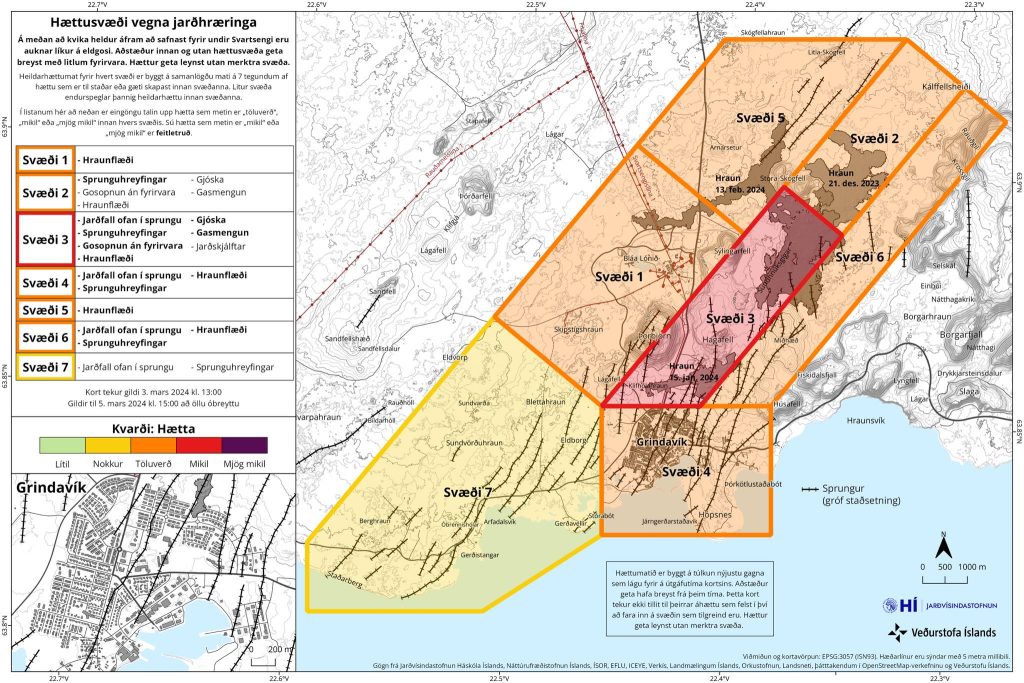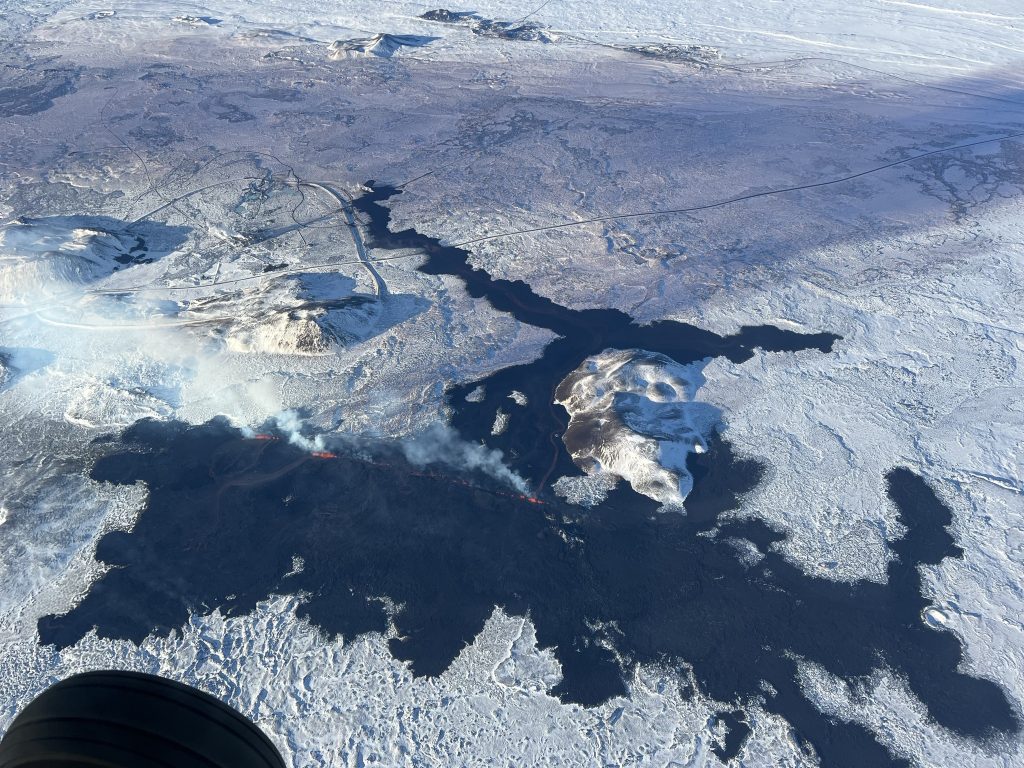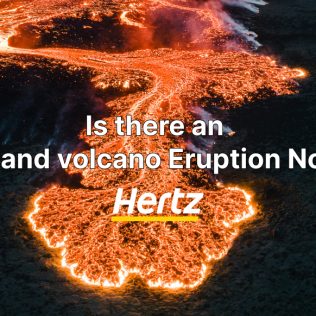22 May 2024 Update ?: The Icelandic volcano eruption is now OVER. We do NOT have an active volcano eruption on-going now in Iceland
__________________________________________
(15 March 2024 Update?)
Iceland is currently witnessing the power of nature through an ongoing volcanic eruption on the Reykjanes Peninsula. This event is part of the 2023–2024 Sundhnúkagígar eruptions; due to the ongoing volcano eruption, the Blue Lagoon is temporarily closed, and the area is CLOSED for access, hiking and visiting the area on foot/car is PROHIBITED.
This quick guide will uncover the mysteries of this volcanic terrain, offering insights into the formation of its remarkable landscapes. We will also provide essential guidance on navigating the challenges that can be presented by Icelandic volcano eruptions, including safety precautions during the event.

Myndir: Almannavarnir
Is there a volcano eruption in Iceland? Is Iceland airport affected?
Yes, as of 2nd of April 2024, Iceland is having a volcano eruption. Despite the dramatic natural events, Keflavik International Airport, a crucial hub for international travelers, remains unaffected, ensuring that air travel to and from Iceland continues as usual
Can I visit the volcano eruption area at Sundhnukagigar?
No. The Reykjanes volcano area is currently restricted, and authorities urge the public not to attempt visiting the eruption by hiking or driving to the sites due to potential dangers. The only safe way to view the eruptions is via helicopter tours designed to offer a glimpse of the volcanic activity without risking safety.
Why can’t I visit the eruption site like the Litli-Hrútur?
The area’s closure is underscored by the high risk of new fissures, unpredictable lava flows, and a reported incident where an individual went missing after falling into a crevice, highlighting the hazardous conditions. Authorities have declared an Emergency/Distress Phase, emphasizing the danger to both people and infrastructure near the eruption site
Check the danger zones around Grindavik town identified by the Icelandic Civil Protection:

What should I do when there is a volcanic eruption in Iceland?
During a volcanic eruption in Iceland, it’s essential to prioritize safety and take necessary precautions. Here’s a list of actions to follow if volcanic activity is taking place while you’re in Iceland:
- Check safetravel.is for alerts and updates regarding the eruption, including information on road closures, evacuation orders, and safety advisories.
- Visit almannavarnir.is to access updates from the Icelandic Civil Protection Department on their response to the eruption, including emergency procedures, evacuation routes, and shelters.
- Monitor road.is to ensure avoidance of closed roads and dangerous areas, as volcanic eruptions can lead to road closures, landslides, and hazardous conditions.
- Keep an eye on the icelandic meteorological office website: vedur.is for weather-related alerts, as volcanic eruptions can influence weather patterns, including ash plumes, pyroclastic flows, and volcanic lightning.
- For assistance, including road closures, vehicle issues, or emergency evacuations, contact Hertz Iceland at +354 858 04 99 or call 112 for emergencies.
- Take shelter indoors and close all windows and doors to prevent ash infiltration. Volcanic ash can pose respiratory health risks and damage property.
- Stay away from the eruption site, as it can be hazardous due to lava flows, volcanic gases, and ashfall, and follow instructions from local authorities regarding evacuation zones and safety measures.
By following these guidelines, you can ensure your safety and well-being during a volcanic event in Iceland.

Myndir: Almannavarnir
Background information about the eruption site
Since October 2023, Sundhnúkur region on Reykjanes Peninsula has been a focal point of seismic unrest, leading up to the 2023-2024 Sundhnúkagígar eruptions.
The Beginning of the Eruption
The seismic activity escalated in late October 2023, culminating in a significant earthquake swarm around the Þorbjörn and Svartsengi areas. This was attributed to magma forcing its way towards the surface, causing over 1,000 earthquakes in the initial burst and over 22,000 since the swarm began.
By November 2023, the largest of these earthquakes reached a magnitude of 5.3, an alarming sign of the volcanic system stirring to life. It was during this period that sulfur dioxide, indicative of magma near the surface, was detected, raising alerts for a potential eruption.

Myndir: Almannavarnir
Eruptions on the Reykjanes Peninsula
The Sundhnukagigar eruptions form part of a broader pattern of volcanic activity on the Reykjanes Peninsula, a region that has entered a new volcanic cycle after about 800 years of dormancy. This cycle is expected to last for several centuries, with eruptions occurring at various locations across the peninsula.
Recent eruptions near Grindavík and the subsequent lava flows, notably in December 2023 and February and March 2024, did not cause harm to people but did impact infrastructure, like the destruction of a water pipe and road closures. These events underline the dynamic and unpredictable nature of volcanic activity in the area.
A Note on Safety
The Icelandic Meteorological Office, alongside local authorities, closely monitors the volcanic activity, seismic movements, and the impact on the earth’s crust, significance of Hagafell and Stóra Skógfell within this context cannot be overstated.
Residents of affected areas have experienced evacuations and disruptions, emphasizing the importance of adhering to safety guidelines and staying informed through official channels las we mentioned earlier in this blog.

Myndir: Almannavarnir
Looking Ahead
Iceland’s rich volcanic landscape continues to fascinate and remind us of the earth’s ever-changing nature. While the Sundhnúkur eruptions present a spectacle of nature’s power, they also serve as a reminder of the need for preparedness and respect for natural forces. As we witness the earth’s crust reshaping before our eyes, with lava fields expanding and craters forming, we’re reminded of the dynamic planet we inhabit.
For travelers, the ongoing eruptions are a testament to Iceland’s raw beauty and the forces that shape it. Though visiting the eruption sites is currently off-limits, Iceland remains a destination of unparalleled natural wonder. Safety remains paramount, and following guidelines ensures that both residents and visitors can experience the majesty of Iceland’s landscapes without harm.

